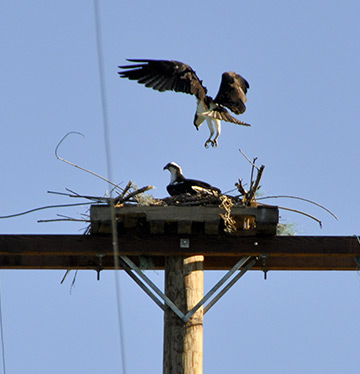Protecting birds
PSE’s Avian Protection Program promotes a company-wide consistent avian-safe approach throughout our service area. Since the 1980’s PSE has been working to protect birds and their habitats by responding to bird-power line interactions, implementing bird-friendly construction standards to reduce the risk of bird electrocutions and collisions, coordinating with Vegetation Management and construction Project Managers to minimize impacts on nesting birds and habitat, and coordinating with State and Federal Wildlife Agencies, Wildlife Rehabilitators, and others to help address avian concerns region-wide. While it is not possible to prevent all injurious contact between birds and electric equipment, we make significant investments to reduce the number of incidents.
Our Avian Protection Program is recognized by federal wildlife officials as an industry model for reducing the impact of utility equipment on migrating and resident bird populations. While the bald eagle population has increased significantly over the years, we've seen no increase in eagle fatalities from contact with our electrical system. Trumpeter swan-power line collisions as well as small-bird fatalities also have been reduced through our efforts. All of these reductions are a testament to the effectiveness of our bird-protection program.
We are continuously evaluating our program and the procedures we have in place to continue to reduce our electrical system's impact on birds.
Learn how
- We conduct bird surveys near our electrical facilities to assess problem areas and identify high-priority sites for bird-protection efforts.
- We work with our engineers, utility-infrastructure planners, and vegetation management to minimize impacts on avian habitats.
- We exchange information and partner in the field with the United States Fish and Wildlife Service and the Washington Department of Fish and Wildlife on bird-protection initiatives.
- We respond to bird issues at company facilities and take corrective actions throughout our service area.
- We implement and continually refine avian-friendly construction standards to prevent or minimize bird interactions with our electrical system.
- We operate the Avian Protection Program under a Federal Special Purpose Utility Permit, and support avian management at PSE’s wind and other generation facilities
We are a member of the Avian/Power Line Interaction Committee and a contributor to its nationally recognized publication, Suggested Practices for Avian Protection on Power Lines and Reducing Avian Collisions with Power Lines.
A few of the specialized tools we use to reduce the risk of bird electrocution:
- Since 1979, we have built more than 65 osprey nest platforms to provide safe nesting alternatives for birds that try to nest on our power poles.
- Since 2004, we have installed more than 8,500 bushing covers on transformers to prevent bird and squirrel electrocutions and reduce power outages, and approximately 4,000 wire covers which allow eagles and other large birds to perch safely on power poles.
- Since 2003, we have installed more than 23,000 bird flight diverter devices to reduce avian-power line collisions by making our conductors more visible to birds, and trumpeter swans in particular.
- Since 2000, we have installed more than 120 perches to provide safe alternative locations for birds to perch in areas with little natural substrate for perching.









